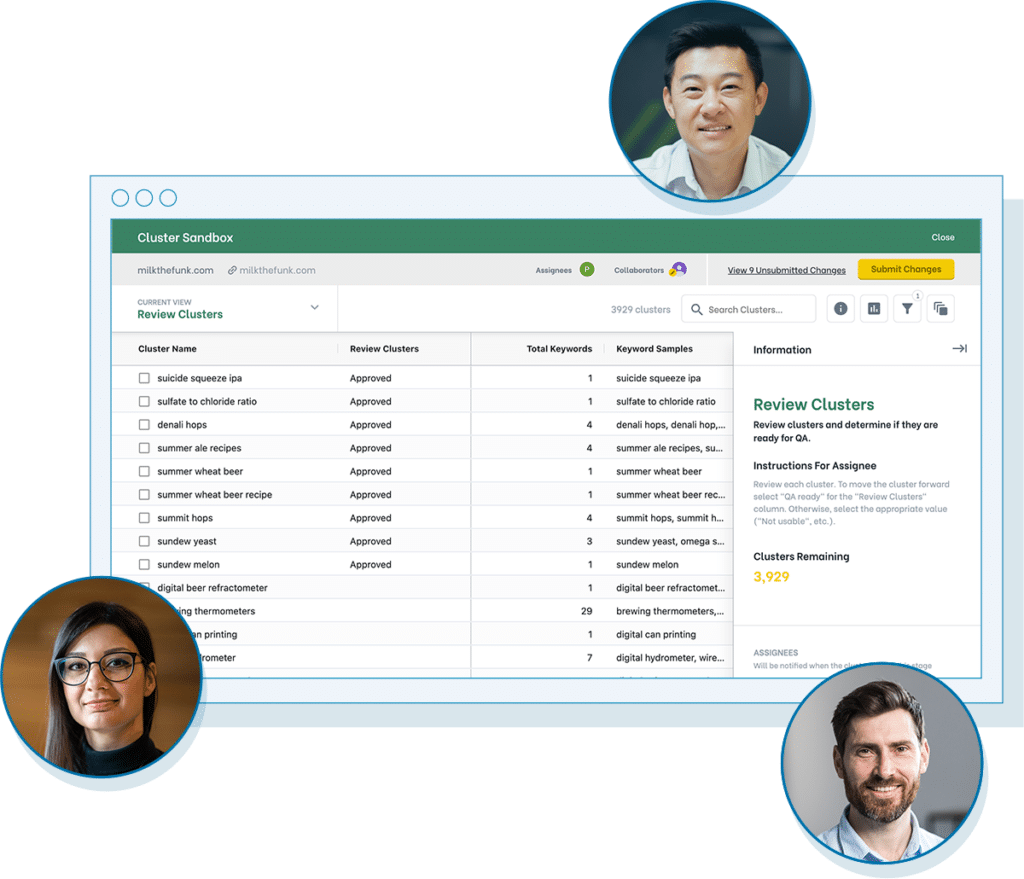One of the biggest challenges in the search engine optimization industry is having a conversation with your client, your boss, or your CEO about the potential outcome of your SEO campaign.
In the PPC field, you can directly measure the difference between the budget that’s allocated to the program and the expected return on ad spend (ROAS) or return on investment (ROI). These are simple, identifiable metrics, and they’re directly connected and controlled by the expert assigned to them.
SEO…not so much.
You can’t guarantee that x, y, or z will generate X amount of clicks, Y amount of leads, or Z amount of sales DIRECTLY. Organic results aren’t a direct pay-to-play game, and nothing is guaranteed.
HOWEVER. If you’ve been around a while, you DO know the strategies that generally work, and GENERALLY end up resulting in additional traffic, leads, and revenue.
But what if you could generate some sort of document that showed the potential of traffic, leads, sales, and revenue? Could you then justify a budget that is assigned to execute on those GENERAL SEO TASKS that create results?
Where do we start?

Bespoke Competitor Analysis
We’ve partnered with Dave Snyder of Copypress to alternatively provide a free, detailed, bespoke, competitor analysis & keyword cluster report

FORECAST SEO REVENUE POTENTIAL & NOT JUST TRAFFIC VOLUME
There are several ways to go about gathering keywords from various SEO tools like Semrush, Ahrefs, and others. You can brainstorm beginning with your starting keyword, conduct customer interviews, use keyword magic and other shortcut tools, or grab keywords from Google Search Console (Yes, even if you have more than 50,000 keyword queries).
My favorite process is to check the target keyword’s results on Google, grab their top 10 rankings, and then get the top 100 keywords from each of those sites (Spoiler alert, that’s our auto-magic process for our keyword forecasting service).
However you obtain it, you need a focused list of keywords and their estimated monthly search volume numbers.
That’s when the fun begins!

Can you predict how much traffic and revnue our SEo campaign will generate?
How To Estimate The Traffic You’ll Get From SEO
Take the estimated search volume from each keyword on your list of keywords relevant to the page and multiply them by the “organic click through rate” for a specific ranking position. This will give you an estimate of how much potential organic traffic you could receive if your site showed up after your optimization efforts.
There are of course a LOT of variables at work here:
- While you can estimate all of your keywords at the same ranking position, it is extremely unlikely that you would get ALL of the keywords you’re targetting to rank at the same position, or at all.
- While you can gather a list of your target keywords, you will likely rank for a mix of additional keywords over time that you should review in search console to consider adding to your list.
- SEO isn’t a magic wand. There is no guarantee that all of your various keywords will see gains in rankings at the same rate. You could acquire a link with a specific anchor link for example that could boost just one specifc phrase.
- There is a HUGE difference between ranking #1, ranking in the top 3, ranking 4-10 and not ranking on the first page at all.
- You need to take into account your own efforts at on-page SEO, interal linking, new content creation and link building for you to come up with a realistic model of how your overall traffic can grow over time.

How to Create a Reasonable Model Estimate of SEO traffic Growth Over Time
Estimate the potential organic traffic your target keyword list for your page, then multiply the total search volume by each ascending ranking position’s organic click through rate(position 12-1). Graph the resulting Google click estimates over 12 months for a very rough 1 year estimate.
To make these results more accurate, since you know that you can’t possibly rank at position 1 for all the terms, you can “dampen” the results in 25% increments to create 4 levels of potential organic estimated traffic.
Do this process for each unique product (product type if they’re all super similar) or service.
- Gather the list of relevant keywords that are most likely actually purchase the product or service.
- Get the total volume of those keywords using a keyword research tool.
- Multiply that volume by a PLAUSIBLE organic click-through rate for a specific ranking, this study by Advanced Web Rankings is pretty good. An “organic click-through rate” is a fancy way of describing what percentage of people who click through on a search result to a website based on the ranking position of that site. Most traffic, upward of 35%. or more always flows to the #1 site. Depending on how “high in rankings” it’s plausible for you, choose an estimated organic CTR for the #1 ranking. This is your potential monthly search traffic for #1 ranking
- Calculate at what rate is traffic that turning into leads by filling out a form, ordering a product, or making a call. (Conversion rate).
- Take your potential traffic number and multiply it by the conversion rate. This is your potential # of conversions.
- Find out how many of your conversions actually turn into sales. **For E-Commerce Agency this is fairly straightforward, but you may need to talk to your sales team about Sales Qualified Leads and other processes first. Once you know how many leads(conversions) you had on your site and how many sales you had from THOSE leads then you can multiply the conversions from step 8.** This is your potential # of sales.
- You need to find out the revenue per sale for this product or service. While this COULD be straightforward for a product, potentially you may need to estimate the AVERAGE revenue from these clients because they could sign up for multiple months, or multiple services at once. For recurring income, find out the average lifetime of a client and multiply your monthly revenue by that value. This is your potential revenue.
- Repeat this process using #6 organic CTR
- This will provide you with two potential SEO Returns on Investment reports based on being “at the top” of the rankings, vs “just being on” the first page.
Here’s a real world example, here’s an online auction software that does paddle raises online, they have a website conversion rate of 2.5% for their software, don’t have a further sales process and make at least $47 per sale. —> Here’s their SEO forecast
| ? Find Relevant Keywords | Gather the list of relevant keywords that are most likely actually purchase the product or service. |
|---|---|
| ? Get Keyword Data | Get the total volume of those keywords using a keyword research tool. |
| ? Calculate CTR | Multiply that volume by a PLAUSIBLE organic click through rate for a specific ranking |
| ? Figure Out Conversion Rate | Calculate at what rate is traffic that turning into leads by filling out a form, ordering a product, or making a call. (Conversion rate) |
| ? Calculate Conversions | Take your potential traffic number and multiply it by the conversion rate. This is your potential # of conversions. |
| ? Estimate Sales | Find out how many of your conversions actually turn into sales. |
| ♦️ Forecast potential revenue from SEO | You need to find out the revenue per sale for this product or service, & multiply it by the number of sales. |
| ? Repeat for ALL potential ranking positions | Make a sheet full of estimated numbers for each SERP ranking position |
| ? Group SEO Estimates Into “Potential ranges” | You’re unlikely to rank all number one, so create realistic estimates by grouping potential outcome scenarios. |
Actionable Recommendation: Group Your Keywords By Conversion Potential
My recommendation for this is to not look at/forecast on a per-term basis, but instead when forecasting ROI for your content marketing service do it in groups or as a whole (e.g. all terms that make up a certain topical niche, or all terms that reflect the current footprint for a site).
By grouping things together, you get a better understanding of topical opportunity and risk/rewards (when looking at KW difficulty, revenue opps, etc). Don’t forget to actually look at the SERP results to make sure you’re not optimizing a mismatched keyword.
An Alternate Process For Calculating Potential SEO Traffic
- I identify current device% breakout between mobile and desktop via analytics data
- I use Rand/Jumpshots study of click death by device type (this may be controversial to some people, but I’ve noticed it models our actual data pretty decently)
- desktop/mobile search volume from your tool of choice (e.g. SEMrush, Ahrefs, etc.)
- averaged CTR for top five positions (generally what we’re shooting for re: rankings), pulled from top X keywords in GSC
- *You can also take extra steps to consider “Keyword difficulty* in your forecast*
So, for example:
I want to project what my outcomes may be if I rank in top 5 for any given set of terms, thereby projecting what my opportunity is if I try to invest. This can be used in conjunction with other metrics, such as average difficulty for a corpus of keywords, etc. to make decisions on re: do you invest your time in them or not.
Here are the things I work through –
Calculating target ranking position (target ranking position = top 5) average – I recommend doing this for desktop and mobile to use the relative CTR for each later on:
- I pulled the top & longtail keywords from GSC into sheets for the last 6 months (capped out the pull at around 50k terms gathered)
- I rounded the position data to nearest whole position and applied groupings to them (position 1, top 3, first page, etc.) for future analysis
- I used averageif on CTR for all top 10 positions (averageif pos = 1, averageif pos =2, etc.)
- Then, I average the top 5 position averages, giving me a relative average for if I ranked in the top 5 positions
- this % gets used in final equation
Find device breakout for current audience:
- from your analytics of record (Omniture, GA, etc.), find out the device breakout by mobile vs desktop
- these % get used in final equation
Leverage click data from Rand/Jumpshot study:
- While a recent study – and one which people may scoff at, or ignore – I find being mindful of loss-of-click to be an important element; if you trust the click potential data from Ahrefs or SEMrush, you could use that info on the keyword level instead of using this broad study
- let’s say we don’t use Ahrefs or SEMrush click estimates though, I would use the 39% clicks on mobile (61% no clicks was the number referenced in the study), and 65% clicks on desktop (34.5% no clicks was number referenced in study) in my final equation
Get desktop AND mobile data for keywords, as available:
- for each term I’m going to include in my corpus for this analysis, I will try to get both the desktop data as well as the mobile data; if mobile data is not available (or vice versa), then I will use whatever is available
- the keyword data could be for existing rankings (current marketshare/footprint), and/or for new terms we want to go after (gap footprint) – these can be used to support different questions (e.g. should we invest in optimizing current content and what would outcomes potentially be if so)
- data needed = search volume and current ranking position (if pulling for current footprint)
Based on all this data, we can now calculate traffic potential.
Traffic potential = ((mobile sv*0.39) * mobile traffic %) * avg T5 mobile CTR + ((desktop sv * 0.65) * desktop traffic %) * avg T5 desktop CTR
This equation is applied to every keyword we currently rank for, not in the top 5 (e.g. position 6-100).
This should give us insights into answering the question of “if we improve our ranking position for this corpus of keywords, what might the traffic estimate look like”.
You can then use this in comparison/conjunction with other metrics, like average difficulty for a topical category (e.g. risk reward based on comp to traffic opp), etc.

Good deal Jeremy. I dig this approach because it comes from strong clarity. Laying out estimates and services lets potential clients know where you are coming from, to better find matches.
Ryan